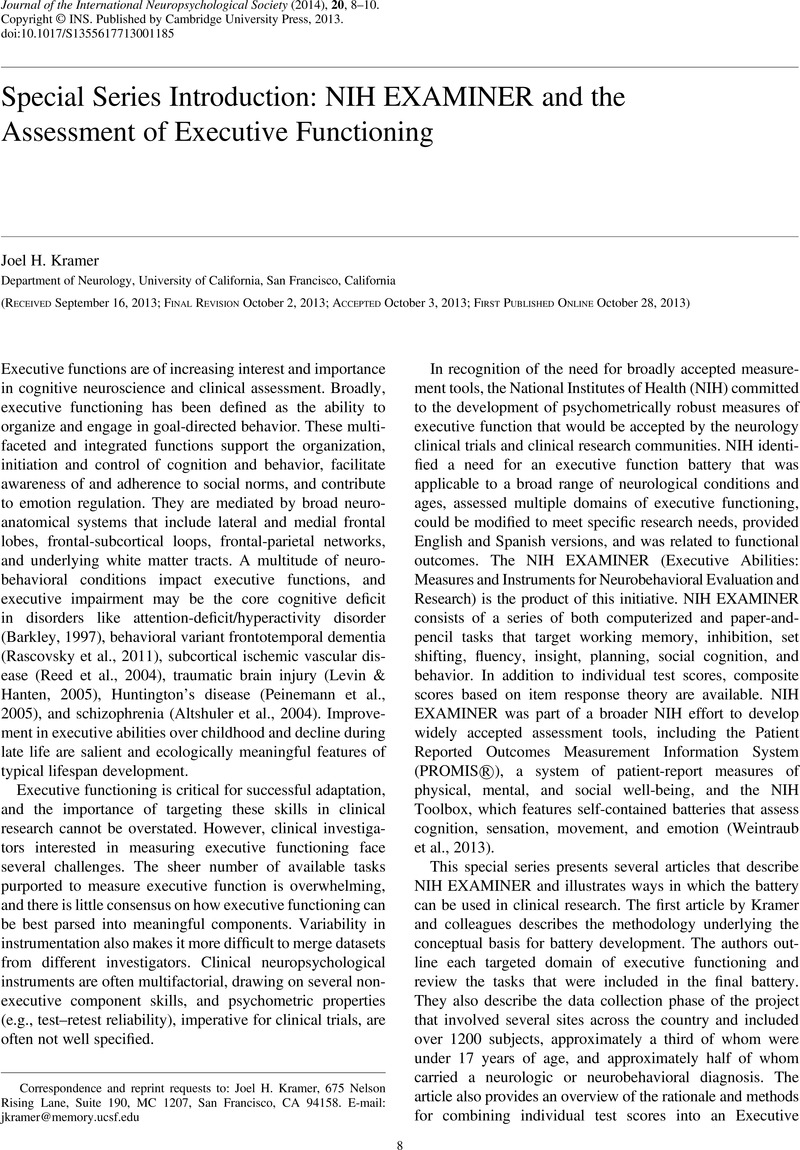Crossref Citations
This article has been cited by the following publications. This list is generated based on data provided by Crossref.
Slama, Hichem
Deliens, Gaétane
Schmitz, Rémy
Peigneux, Philippe
Leproult, Rachel
and
Vyazovskiy, Vladyslav
2015.
Afternoon Nap and Bright Light Exposure Improve Cognitive Flexibility Post Lunch.
PLOS ONE,
Vol. 10,
Issue. 5,
p.
e0125359.
Bettcher, Brianne M.
Mungas, Dan
Patel, Nihar
Elofson, Jonathan
Dutt, Shubir
Wynn, Matthew
Watson, Christa L.
Stephens, Melanie
Walsh, Christine M.
and
Kramer, Joel H.
2016.
Neuroanatomical substrates of executive functions: Beyond prefrontal structures.
Neuropsychologia,
Vol. 85,
Issue. ,
p.
100.
Stiver, Jordan
and
Kramer, Joel H.
2017.
Encyclopedia of Clinical Neuropsychology.
p.
1.
Stiver, Jordan
and
Kramer, Joel H.
2018.
Encyclopedia of Clinical Neuropsychology.
p.
1352.
Erickson, Sarah J
Hile, Sarah
Rieger, Rebecca E
Moss, Natalia C
Dinces, Sarah
and
Annett, Robert D
2019.
Association Between Executive Functioning and Functional Impairment Among Pediatric Cancer Survivors and Controls.
Archives of Clinical Neuropsychology,
Vol. 34,
Issue. 5,
p.
599.
Yang, J
Ru, T
Chen, Q
Mao, T
Ji, Y
and
Zhou, G
2019.
The effects of ambient light on task switching depend on the chronotype.
Lighting Research & Technology,
Vol. 51,
Issue. 4,
p.
544.
Erickson, Sarah J.
Hile, Sarah
Kubinec, Nicole
and
Annett, Robert D.
2020.
Self-reported and parent proxy reported functional impairment among pediatric cancer survivors and controls.
Health and Quality of Life Outcomes,
Vol. 18,
Issue. 1,
Okafor, Maureen
Nye, Jonathon A.
Shokouhi, Mahsa
Shaw, Leslie M.
Goldstein, Felicia
Hajjar, Ihab
and
Gross, Alden
2020.
18F-Flortaucipir PET Associations with Cerebrospinal Fluid, Cognition, and Neuroimaging in Mild Cognitive Impairment due to Alzheimer’s Disease.
Journal of Alzheimer’s Disease,
Vol. 74,
Issue. 2,
p.
589.
Hajjar, Ihab
Okafor, Maureen
McDaniel, Darius
Obideen, Malik
Dee, Elizabeth
Shokouhi, Mahsa
Quyyumi, Arshed A.
Levey, Allan
and
Goldstein, Felicia
2020.
Effects of Candesartan vs Lisinopril on Neurocognitive Function in Older Adults With Executive Mild Cognitive Impairment.
JAMA Network Open,
Vol. 3,
Issue. 8,
p.
e2012252.
Clark, David J.
Chatterjee, Sudeshna A.
Skinner, Jared W.
Lysne, Paige E.
Sumonthee, Chanoan
Wu, Samuel S.
Cohen, Ronald A.
Rose, Dorian K.
and
Woods, Adam J.
2021.
Combining Frontal Transcranial Direct Current Stimulation With Walking Rehabilitation to Enhance Mobility and Executive Function: A Pilot Clinical Trial.
Neuromodulation: Technology at the Neural Interface,
Vol. 24,
Issue. 5,
p.
950.
Hajjar, Ihab
Okafor, Maureen
Wan, Limeng
Yang, Zhiyi
Nye, Jonathon A
Bohsali, Anastasia
Shaw, Leslie M
Levey, Allan I
Lah, James J
Calhoun, Vince D
Moore, Reneé H
and
Goldstein, Felicia C
2022.
Safety and biomarker effects of candesartan in non-hypertensive adults with prodromal Alzheimer’s disease.
Brain Communications,
Vol. 4,
Issue. 6,
Hoffman, Linda J.
Mis, Rachel E.
Brough, Caroline
Ramirez, Servio
Langford, Dianne
Giovannetti, Tania
and
Olson, Ingrid R.
2023.
Concussions in young adult athletes: No effect on cerebral white matter.
Frontiers in Human Neuroscience,
Vol. 17,
Issue. ,



